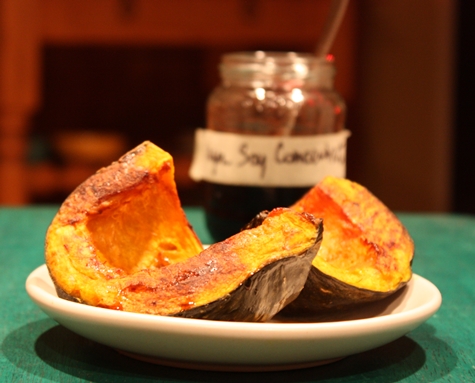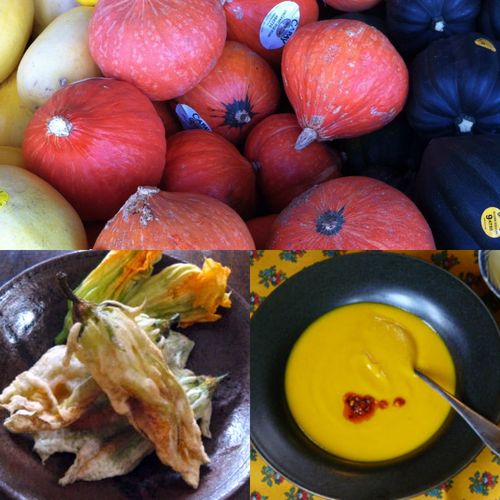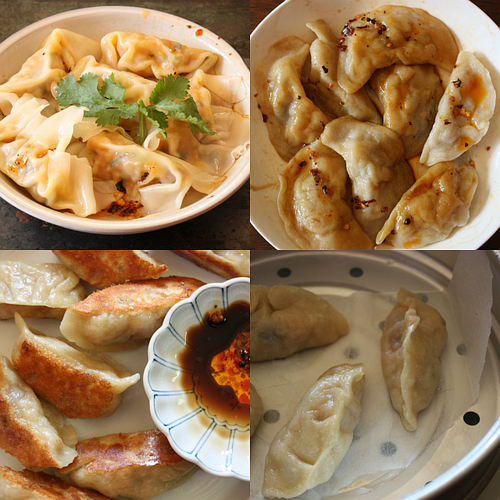If you live in the northern hemisphere, it’s hard to escape
pumpkins and various hard fall/winter squashes these days. They’re displayed by the
front doors of grocery stores and end-caps in the produce section. Farmers are
bringing them to our weekly markets and there are better and bigger selections
at Asian grocers. Halloween-carved pumpkins and related holiday decor are front
and center in store ads and people’s lawns. Food magazines are loaded with photos and recipes for squash-centric dishes for Thanksgiving
celebrations. It's a food that screams autumn in color and evokes the coziness of the cooler weather ahead.
In Vietnamese, a generic term for squash is bi and one with red/orange/yellow flesh (e.g.,
pumpkin, kabocha and butternut) is bi do.
We bought a pumpkin to carve for Halloween a couple of weeks ago but instead of
thinking about cutting into it for decoration, I pondered hard squash and
pumpkin recipes.
No, I’m not saying I cook with pumpkins raised for carving.
They don’t taste good. We mistakenly bought a wedge of Cinderella pumpkin from
a Mexican market last month and it looked gorgeous in the oven but tasted blah
on the plate. At the store, I recognized it in its cut form as a decorative
pumpkin but since it was sold under the auspices of being good for cooking, I
tried it out. Don’t do it. It’s not worth it.
For cooking, I like kabocha (can’t lose with this Asian
favorite), butternut (sweet, creamy orange flesh), kuri (has a chestnut-like
texture and flavor), and banana (firm flesh, conveniently sold in sections at
supermarkets). I’ve been meaning to try baby cooking pumpkins as they’d
probably work well in recipes.
To prep fall and winter’s bounty of hard squash, I reach for
a cleaver, vegetable peeler, and grapefruit knife. The cleaver is great for
hacking into a big hard squash; if it’s an extra heavy one, use a rubber mallet
to help get the blade through. The peeler is good for removing the tough skin
of butternut squash. A grapefruit knife’s curved blade is handy for scraping
out seeds and stringy fibers lingering in the center cavity; if you don’t have
a grapefruit knife, use a spoon.
Several ways to cook up these orangey beauties and their
parts:
Fried Squash Blossoms
are enjoyed at the Viet table as much as anywhere else. If you grow any
kind of squash, you’ll have blossoms to pick and eat. Pumpkin and other hard
squashes tend to have larger flowers than summer squash like zucchini. But you
can treat them similarly, or select relatively small ones for this recipe.
Large squash blossoms are great and easy to stuff and steam, an approach that I’ve
seen in older Vietnamese cookbooks. Deep-frying is so darn nice though.

Roasted squash with
soy sauce is combination that I gleaned from a friend in high school. I
went over to her house one day and her mom was eating half a table queen squash
that had been roasted with a drizzle of soy sauce. Her mom said it was easy,
nutritious and satisfying for a woman like her who was going through menopause.
Lots of takeaways in that experience and since I’m not yet in that stage in
life, I’ll keep that tip in my back pocket while I simply enjoy my roasted
squash. Here’s an example
of how to roast the squash and enjoy it with a Japanese vegan soy concentrate
(soy sauce that you doctor up to be extra delicious).
Pumpkin and coconut
milk are a match made in heaven. Instead of regular or sweet potato, I cut
up butternut or banana squash into thumbnail size cubes and drop them into a
simmering pot of coconut-milk laden Thai curry; try it in place of potato in the
Thai
yellow curry with beef. The result is a great flavor and color contrast. If
you have Into the Vietnamese Kitchen,
the winter squash simmered in coconut milk recipe on page 176 is terrific. The
vegan dish combines peanuts with banana squash and sweet potato in a creamy
sauce.
Pumpkin, lime leaf,
and coconut soup (at the top of the post) plays off the idea of combining
pumpkin and coconut milk. The recipe was something I came up with for my
husband’s aunt who was basically on her deathbed and couldn’t eat solid food.
She lived for two more years after I made the soup for one of the last
Thanksgiving dinners with her. The recipe
is easy and you can zip things up with chile oil, if you like.
Roasted kabocha and vegetable
dumplings is a terrific way to use leftover roasted winter squash. It’s
savory-sweet and loaded with color and texture. I made it in response to a few
so-so renditions of pumpkin dumplings I had at Asian restaurants. As shown in the above photo, this vegan recipe
can be cooked in many ways.
So what are your
pumpkin tips and tricks for the season?
Related posts:



















Yun Ho says
Hi Andrea:
In Korea, we have "Sweet Pumpkins" and they look more like table queen squash. We would cut off the "lid" empty the seeds, them stuff them with black rice, chestnuts, pine nuts, ginko nuts, dried chinese dates, regular and glutinous rice. Then we would put back the lid on and steam them in a steamer. The result is called Sweet Pumpkin Nutritious Rice and has a nice purple color from the black rice.
Suzette says
My husband's great-aunt made a dessert with a kabocha, that involves the same process! It was filled with an eggy custard, and steamed it whole (it may have been a little pre-cooked before the custard). It was cooled, and then served in slices, so you see the contrast of the blazing orange squash against the sunny yellow custard. Very yummy dessert!
Andrea Nguyen says
That sounds amazing, Yun Ho. The rice and other ingredients would lend a terrific textural contrast. What a presentation.
You Koreans go fancy with your pumpkins.
Andrea Nguyen says
That's a Thai sweet, right? I've seen recipes for something like that in Thai cookbooks. The kabocha is cut as wedges and the inside is filled with orange/yellow custard.
Andrea Nguyen says
Wow, that sounds amazing, Yun Ho. The various ingredients must lend an amazing mixture of textures, colors and flavors. You Koreans go fancy when pumpkins come into season. I've never heard of that recipe before.
Yun Ho says
I will e-mail you the recipe. This recipe stresses the fact that all the ingredients are supposed to be healthy for you. They have become more popular these days with all the medicinal benefits of this recipe.
Cathy says
I thought I'd let you know what your mention of vegan soy concentrate inspired. First, soba noodles with broccoli, dried shiitakes, and miso marinated sablefish, then the soy concentrate using the dried shiitake stems. But the foray into the top shelf of the pantry revealed, in addition to the kombu, four large bags of shiitakes, a bag of bonito flakes, two unopened bags of wakame and two unopened packages of nori So I had to make a seaweed salad. And dashi. And this afternoon I'm going to roast some nori with a bit of salt. And then it will be soba noodles with rehydrated shiitakes and more broccoli. But then I'll have more shiitake stems and the cycle will start all over again! Thanks for all the inspiration!
Alan Drucker says
Cut in 1 inch strips remove seeds and steam for 10 minutes Easy Tasty Sweet